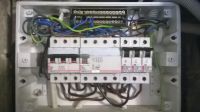Gentlemen, I have a small problem with the voltage on the socket pin. I can describe the installations, there is power in the house, 3 fuses on the phases for individual rooms on the board, the Legrand 40A 30mA differential in front of them. I did the installation around the house myself, 3-wire x2.5 cables for sockets, for 3x1.5 switches for 2x1 line halogen lights. If I want to connect the PE wire, it turns off the differential, I decided to check today what is wrong. On the board, I did not connect the PE wire on any phase during the tests, and yet the pin is lit. The tester is lit on the grounding pins, despite disconnected devices and disconnected contacts. The meter shows a result of 4V to 5V, I called all the sockets at the angle that maybe I shorted PE with N somewhere because I have 2 sockets without grounding, everything is well connected, N from N, PE from PE and L from L. I have it on 2 phases and the result identical 4V to 5V. Can this behavior happen if I did not put L on the led switch, but N, and the phase went directly to the leds? Maybe some suggestion what else I can check, and maybe check one phase, and disconnect the other 2 for the time of testing?



